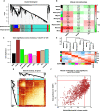HEMGN and SLC2A1 might be potential diagnostic biomarkers of steroid-induced osteonecrosis of femoral head: study based on WGCNA and DEGs screening
- PMID: 33451334
- PMCID: PMC7811219
- DOI: 10.1186/s12891-021-03958-7
HEMGN and SLC2A1 might be potential diagnostic biomarkers of steroid-induced osteonecrosis of femoral head: study based on WGCNA and DEGs screening
Abstract
Background: Steroid-induced osteonecrosis of the femoral head (SONFH) is a chronic and crippling bone disease. This study aims to reveal novel diagnostic biomarkers of SONFH.
Methods: The GSE123568 dataset based on peripheral blood samples from 10 healthy individuals and 30 SONFH patients was used for weighted gene co-expression network analysis (WGCNA) and differentially expressed genes (DEGs) screening. The genes in the module related to SONFH and the DEGs were extracted for Gene Ontology (GO) and Kyoto Encyclopedia of Genes and Genomes (KEGG) pathway enrichment analysis. Genes with |gene significance| > 0.7 and |module membership| > 0.8 were selected as hub genes in modules. The DEGs with the degree of connectivity ≥5 were chosen as hub genes in DEGs. Subsequently, the overlapping genes of hub genes in modules and hub genes in DEGs were selected as key genes for SONFH. And then, the key genes were verified in another dataset, and the diagnostic value of key genes was evaluated by receiver operating characteristic (ROC) curve.
Results: Nine gene co-expression modules were constructed via WGCNA. The brown module with 1258 genes was most significantly correlated with SONFH and was identified as the key module for SONFH. The results of functional enrichment analysis showed that the genes in the key module were mainly enriched in the inflammatory response, apoptotic process and osteoclast differentiation. A total of 91 genes were identified as hub genes in the key module. Besides, 145 DEGs were identified by DEGs screening and 26 genes were identified as hub genes of DEGs. Overlapping genes of hub genes in the key module and hub genes in DEGs, including RHAG, RNF14, HEMGN, and SLC2A1, were further selected as key genes for SONFH. The diagnostic value of these key genes for SONFH was confirmed by ROC curve. The validation results of these key genes in GSE26316 dataset showed that only HEMGN and SLC2A1 were downregulated in the SONFH group, suggesting that they were more likely to be diagnostic biomarkers of SOFNH than RHAG and RNF14.
Conclusions: Our study identified that two key genes, HEMGN and SLC2A1, might be potential diagnostic biomarkers of SONFH.
Keywords: Diagnostic biomarkers; Differentially expressed genes; Peripheral blood; Steroid-induced osteonecrosis of the femoral head; Weighted gene correlation network analysis.
Conflict of interest statement
The authors declare that they have no competing interests.
Figures







Similar articles
-
Pathological mechanisms and related markers of steroid-induced osteonecrosis of the femoral head.Ann Med. 2024 Dec;56(1):2416070. doi: 10.1080/07853890.2024.2416070. Epub 2024 Nov 12. Ann Med. 2024. PMID: 39529511 Free PMC article. Review.
-
Identification and analysis of mitochondria-related central genes in steroid-induced osteonecrosis of the femoral head, along with drug prediction.Front Endocrinol (Lausanne). 2024 Feb 7;15:1341366. doi: 10.3389/fendo.2024.1341366. eCollection 2024. Front Endocrinol (Lausanne). 2024. PMID: 38384969 Free PMC article.
-
Identification of Inflammation-Related Genes and Exploration of Regulatory Mechanisms in Patients with Osteonecrosis of the Femoral Head.Biomed Res Int. 2022 Sep 22;2022:4501186. doi: 10.1155/2022/4501186. eCollection 2022. Biomed Res Int. 2022. PMID: 36193326 Free PMC article.
-
IRF8 and its related molecules as potential diagnostic biomarkers or therapeutic candidates and immune cell infiltration characteristics in steroid-induced osteonecrosis of the femoral head.J Orthop Surg Res. 2023 Jan 10;18(1):27. doi: 10.1186/s13018-022-03381-1. J Orthop Surg Res. 2023. PMID: 36627660 Free PMC article.
-
Mitochondrial maintenance as a novel target for treating steroid-induced osteonecrosis of femoral head: a narrative review.EFORT Open Rev. 2024 Nov 8;9(11):1013-1022. doi: 10.1530/EOR-24-0023. EFORT Open Rev. 2024. PMID: 39513701 Free PMC article. Review.
Cited by
-
Integrated bioinformatics analysis and screening of hub genes in polycystic ovary syndrome.Endocrine. 2022 Dec;78(3):615-627. doi: 10.1007/s12020-022-03181-x. Epub 2022 Sep 6. Endocrine. 2022. PMID: 36068422
-
ARG2, MAP4K5 and TSTA3 as Diagnostic Markers of Steroid-Induced Osteonecrosis of the Femoral Head and Their Correlation With Immune Infiltration.Front Genet. 2021 Jul 26;12:691465. doi: 10.3389/fgene.2021.691465. eCollection 2021. Front Genet. 2021. PMID: 34381494 Free PMC article.
-
Identification and Validation of Potential Ferroptosis-Related Genes in Glucocorticoid-Induced Osteonecrosis of the Femoral Head.Medicina (Kaunas). 2023 Feb 6;59(2):297. doi: 10.3390/medicina59020297. Medicina (Kaunas). 2023. PMID: 36837498 Free PMC article.
-
Pathological mechanisms and related markers of steroid-induced osteonecrosis of the femoral head.Ann Med. 2024 Dec;56(1):2416070. doi: 10.1080/07853890.2024.2416070. Epub 2024 Nov 12. Ann Med. 2024. PMID: 39529511 Free PMC article. Review.
-
Identifying DUSP-1 and FOSB as hub genes in immunoglobulin A nephropathy by WGCNA and DEG screening and validation.PeerJ. 2022 Jul 25;10:e13725. doi: 10.7717/peerj.13725. eCollection 2022. PeerJ. 2022. PMID: 35910761 Free PMC article.
References
-
- Barney J, Piuzzi NS, Akhondi H. Femoral Head Avascular Necrosis. StatPearls. https://www.ncbi.nlm.nih.gov/books/NBK546658/#article-76242.s14. Accessed 6 July 2020. - PubMed
-
- Zhao DW, Yu M, Hu K, Wang W, Yang L, Wang BJ, Gao XH, Guo YM, Xu YQ, Wei YS, et al. Prevalence of nontraumatic osteonecrosis of the femoral head and its associated risk factors in the Chinese population: results from a nationally representative survey. Chin Med J. 2015;128(21):2843–2850. doi: 10.4103/0366-6999.168017. - DOI - PMC - PubMed
MeSH terms
Substances
Grants and funding
LinkOut - more resources
Full Text Sources
Other Literature Sources
Medical
Molecular Biology Databases
Miscellaneous

